
Photo by Mika Baumeister on Unsplash
With the lifting of most COVID-19 pandemic restrictions, most U.S. residents (along with many government officials), fully expected a V-shaped recovery to the economy. That V-shaped recovery did not happen. In fact, things have only gotten worse as inflation skyrockets, fuel prices surge, and supply-chain problems have resulted in empty shelves at your favorite mega-food-marts and retail stores. If you didn’t know any better, you might believe the 1970s have returned, on steroids.
Because there doesn’t seem to be an end in sight for the supply shortage and with the present administration in D.C. not offering any real solutions for solving it, some import/export and shipping companies are taking matters into their own hands and getting creative. One method for upping their game during these hard times is to partner up with an expert forwarder.
Says All Forward, a professional forwarder, companies that can get their goods through the supply chain blockage would do well by working directly with a forwarder who possesses a global directory of trusted partners. Trusted partners translates into companies that have earned excellent peer reviews and who work with other trusted businesses in the shipping industry.
Rather than taking a chance on working with businesses you have little or no information about, a certified forwarder is able to “rely on the experiences of others” to help choose working partners. This, of course, is a terrific long-term plan for any company reliant on the supply-chain. But in the short-term there are still significant problems to deal with that not even the best forwarder can solve on an immediate basis.
According to a new report, with the U.S. struggling to recover completely from the pandemic, supply-chain issues are driving prices up and leading to a goods’ shortage that’s only growing worse on a daily basis. Global supply-chain issues are causing unprecedented shortages of everyday products from electronics, to household goods, to automobiles, and even potato chips.
Trusted business source, Moody’s Analytics, states that the problems are only going to get more dire before they can potentially get better. Whatever steam the economy attempts to generate is immediately hindered by the continued supply-chain problems that seem to be showing up not only at U.S. ports, but ports the globe over.
Causes of the Disruption
Experts attest to the ever-lingering effects of the pandemic mitigation strategies that resulted in a reduction of the production of services and goods. Supply-chain shortages are evidence of the struggle to return to a pre-pandemic level.
Says one Chief U.S. economist, an imbalance between supply and demand has done away with most inventories and all the things that make commerce run far more smoothly. With workers finding it more profitable to stay at home rather than take a minimum wage job, a staggering 4.3 million Americans simply quit their jobs this past summer—a record number, or so states the Department of Labor. Now, the present administration is attempting to make into law a multi-trillion dollar bill that will further distribute helicopter funds to workers who would otherwise be assisting with the supply-chain bottleneck.
The Labor Department has also indicated that the warehouse industry alone recorded close to half a million job openings as of this past July. Again, this is said to be a record. Big companies such as Target, Amazon, and Walmart are doing their best to entice and attract new workers, such as offering them free college tuition.
But with skyrocketing inflation due to never ending money printing, lots of large retail employers find themselves needing to increase wages to keep up with surging prices. This is said to be “intensifying the competition” between businesses to create attractive job offers with the holiday season now in full stride.
As far back as 2019 the American Trucking Association (ATA) estimates that the U.S. would realize a shortfall of 60,000-plus drivers in the coming years. That number only got worse with the pandemic lockdowns, Pandemic Unemployment Assistance and stimulus checks, plus trucker retirements.
A spokesperson for the ATA states that the shortage of drivers is one major contribution to the supply-chain conundrum. But on the bright side, it’s a direct reflection on the “strong demand for goods.” It also means that most everything you purchase in the U.S. is delivered by trucks.
What are Americans to Do?
According to the supply-chain experts, one of the only options for U.S. consumers is to simply wait it out. They should also start “tapering their demands” for the goods they want, or else pay a much higher price should the products suddenly become available again sooner than later. No matter how the government spins it, in the end, higher prices due to supply-shortages and inflation always gets passed on to the consumer.
This content is a joint venture between our publication and our partner. We do not endorse any product or service in the article.

